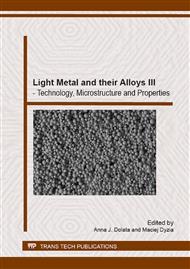p.3
p.9
p.15
p.23
p.31
p.39
p.47
p.53
Effect of Overheating on the Mechanical and Plastic Properties of A390.0 Cast Alloy
Abstract:
The paper presents the results of studies on the effect of the A390.0 (AlSi17Cu5) alloy overheating to a temperature of 920°C and modification with phosphorus (CuP10) on the resulting mechanical (HB, Rm, R0.2) and plastic (A5 and Z) properties. It has been shown that, so-called, "time-thermal treatment" (TTT) of an alloy in the liquid state, consisting in overheating the metal to about 250÷300°C above Tliq, holding at this temperature and rapid cooling, refines the structure and improves the mechanical properties. It has also been found that strong overheating of alloy above Tliq "enhances" the process of modification, resulting in the formation of fine-grain structure. The primary silicon crystals uniformly distributed in the eutectic and characteristics of the α (Al) solution supersaturated with alloying elements present in the starting alloy composition (Cu, Fe) provide not only an increase of strength at ambient temperature but also at elevated temperature (250°C), which is of particular importance for the automotive applications, especially as regards cast pistons operating in IC.
Info:
Periodical:
Pages:
9-14
Citation:
Online since:
November 2013
Authors:
Price:
Сopyright:
© 2014 Trans Tech Publications Ltd. All Rights Reserved
Share:
Citation:


